Discover 35 hidden attractions, cool sights, and unusual things to do in Montgomery (United States). Don't miss out on these must-see attractions: Alabama State Capitol, The Legacy Museum, and National Memorial for Peace and Justice. Also, be sure to include Confederate Memorial Monument in your itinerary.
Below, you can find the list of the most amazing places you should visit in Montgomery (Alabama).
Table of Contents
Alabama State Capitol
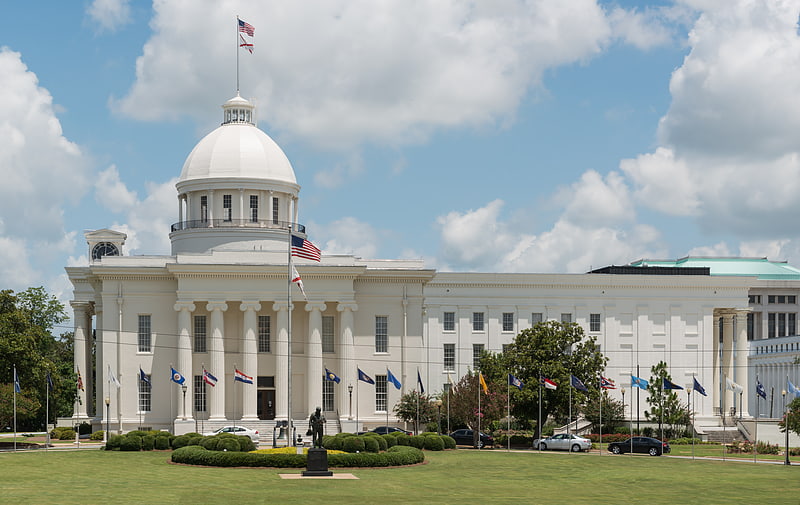
Museum in Montgomery, Alabama. The Alabama State Capitol, listed on the National Register of Historic Places as the First Confederate Capitol, is the state capitol building for Alabama. Located on Capitol Hill, originally Goat Hill, in Montgomery, it was declared a National Historic Landmark on December 19, 1960. Unlike every other state capitol, the Alabama Legislature does not meet there, but at the Alabama State House. The Capitol has the governor's office and otherwise functions as a museum.
Alabama has had five political capitals and four purpose-built capitol buildings during its history since it was designated as a territory of the United States. The first was the territorial capital in St. Stephens in 1817; the state organizing convention was held in Huntsville in 1819, and the first permanent capital was designated in 1820 as Cahaba. The legislature moved the capital to Tuscaloosa in 1826, where it was housed in a new three-story building. The 1826 State House in Tuscaloosa was later used as Alabama Central Female College. After it burned in 1923, the ruins were retained within Capitol Park.
Finally, in 1846, the capital was moved again, when Montgomery was designated. The first capitol building in Montgomery, located where the current building stands, burned after two years. The current building was completed in 1851, and additional wings were added over the course of the following 140 years. These changes followed the development of greater population in the state, as European-American settlers moved in, often accompanied by their slaves, or purchasing more enslaved African Americans after arrival here. Large parts of the state were developed for King Cotton, and the population spread across it.
The current capitol building temporarily served as the Confederate Capitol while Montgomery served as the first political capital of the Confederate States of America in 1861, before Richmond, Virginia was designated as the capital. Delegates meeting as the Montgomery Convention in the Senate Chamber drew up the Provisional Constitution of the Confederate States on February 4, 1861. The convention also adopted the Permanent Constitution here on March 11, 1861.
In 1964, more than one hundred years later, the third Selma to Montgomery march ended at the front marble staircase of the Capitol, with the marches and events surrounding them directly leading to the Voting Rights Act of 1965.[1]
Address: 600 Dexter Ave, 36130-3008 Montgomery (Downtown Montgomery)
The Legacy Museum

Museum in Montgomery, Alabama. The Legacy Museum: From Enslavement to Mass Incarceration is a museum in Montgomery, Alabama, that displays the history of slavery and racism in America. This includes the enslavement of African-Americans, racial lynchings, segregation, and racial bias.[2]
Address: 115 Coosa Street, Montgomery (Downtown Montgomery)
National Memorial for Peace and Justice
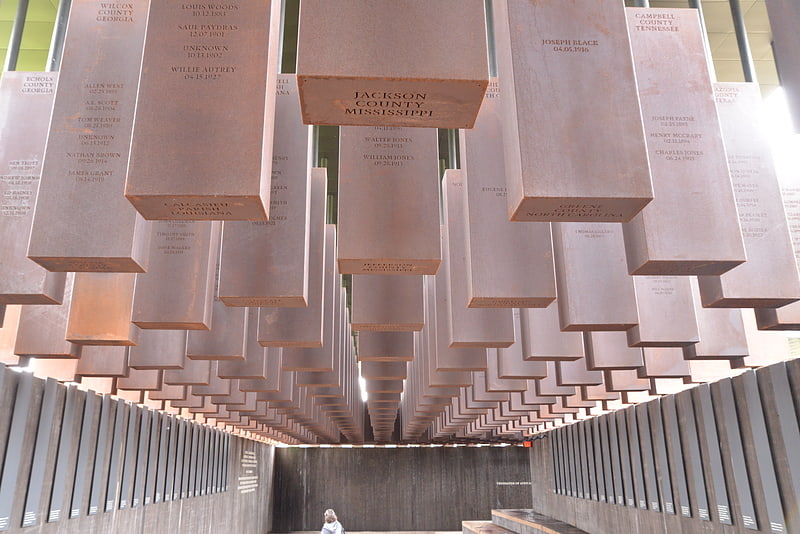
Memorial park in Montgomery, Alabama. The National Memorial for Peace and Justice, informally known as the National Lynching Memorial, is a national memorial to commemorate the black victims of lynching in the United States. It is intended to focus on and acknowledge past racial terrorism and advocate for social justice in America. Founded by the non-profit Equal Justice Initiative, it opened in downtown Montgomery, Alabama on April 26, 2018.
It consists of a memorial square with 805 hanging steel rectangles representing each of the U.S. counties where a documented lynching took place. It also includes several sculptures depicting themes related to racial violence.
The monument was positively received by architectural critics, activists, and the general public. Philip Kennicott of The Washington Post described it as "one of the most powerful and effective new memorials created in a generation".[3]
Address: 417 Caroline Street, Montgomery
Confederate Memorial Monument
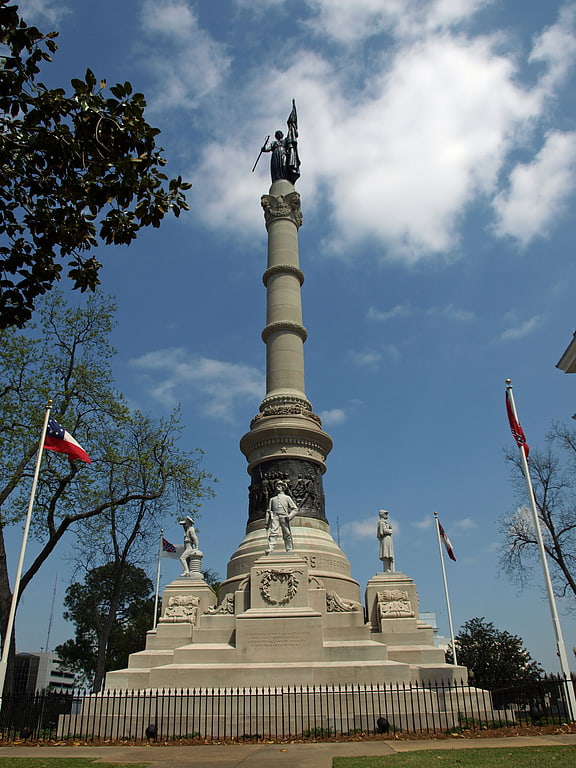
Sculpture by Alexander Doyle. The Confederate Memorial Monument is a monument installed outside the Alabama State Capitol.[4]
Montgomery Riverwalk Stadium

Ballpark in Montgomery, Alabama. Montgomery Riverwalk Stadium is the home of the Montgomery Biscuits of the Double-A South. The minor league baseball ballpark opened in Montgomery, Alabama in 2004. Located in downtown Montgomery, the stadium can host up to 7,000 people a night.
Riverwalk Stadium is a converted century-old train shed. The actual train station is located two blocks away from the field. The abandoned train shed is what is on the exterior of the first base side of the park. Riverwalk Stadium is located near the Alabama River. Montgomery offers a riverfront area that is easily accessible from Riverwalk Stadium with a children's splash pad. There is also an amphitheater located behind the field.[5]
Address: 200 Coosa St, 36104-2509 Montgomery (Downtown Montgomery)
Civil Rights Memorial
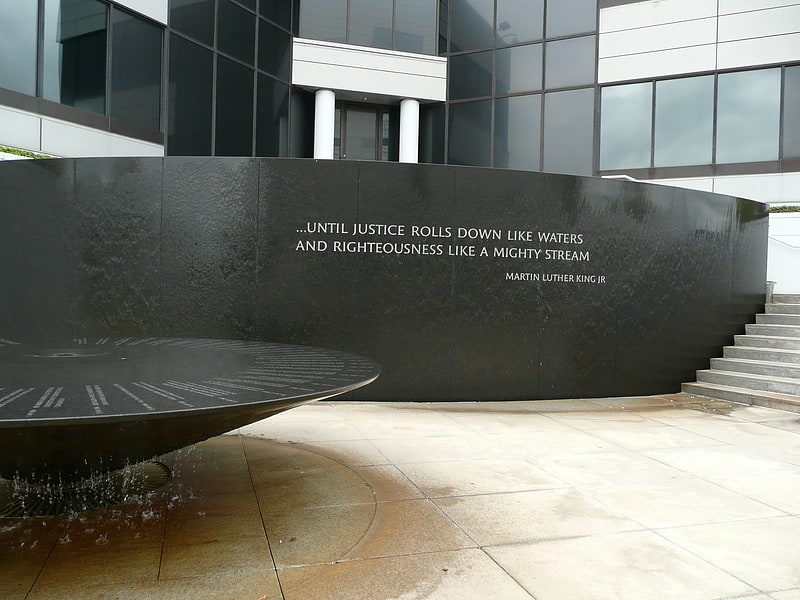
Museum in Montgomery, Alabama. The Civil Rights Memorial is an American memorial in Montgomery, Alabama created by Maya Lin. The names of 41 people are inscribed on the granite fountain as martyrs who were killed in the civil rights movement. The memorial is sponsored by the Southern Poverty Law Center.[6]
Address: 400 Washington Ave, 36104 Montgomery (Downtown Montgomery)
Alabama Department of Archives and History
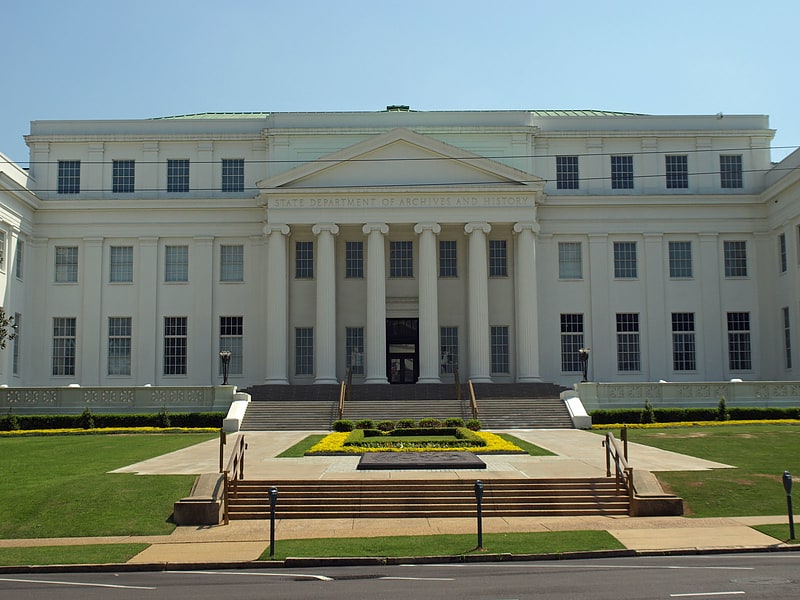
Archive in Montgomery, Alabama. The Alabama Department of Archives and History is the official repository of archival records for the U.S. state of Alabama. Under the direction of Thomas M. Owen its founder, the agency received state funding by an act of the Alabama Legislature on February 27, 1901. Its primary mission is the collecting and preserving of archives, documents and artifacts relating to the history of the state. It was the first publicly funded, independent state archives agency in the United States. It subsequently became a model for the establishment of archives in other states. Today the agency identifies, preserves, and makes accessible records and artifacts significant to the history of the state and serves as the official repository for records created by Alabama's state agencies.[7]
Address: 624 Washington Ave, 36130-0100 Montgomery (Downtown Montgomery)
Garrett Coliseum
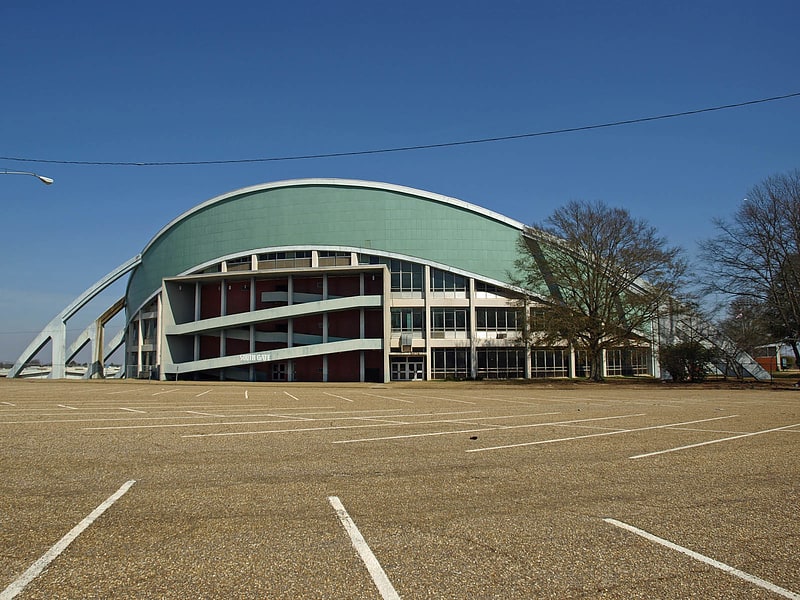
Arena in Montgomery, Alabama. The Garrett Coliseum is a 12,500-seat multi-purpose arena in Montgomery, Alabama, United States. The arena is the centerpiece of the Alabama Agricultural Center, home to the Alabama National Fair. It was built in 1951 and named after W. W. Garrett, the first chairman of the Alabama Agricultural Board. The coliseum's first event was a concert by Hank Williams. In 2005 and 2006, it was home to the Montgomery Maulers of the National Indoor Football League. The arena contains 8,500 permanent seats and can seat up to 10,500 for end-stage shows, 12,500 for boxing, wrestling and center-stage concerts. The Garrett Coliseum Complex is also home to the official state horse show, by Law on the books the Alabama Open Horsemans Association State Championship Horse Show, which is held every year on Labor Day Weekend.
Garrett Coliseum is unique among indoor arenas for its bandstand which is located at the coliseum's stage end. The Coliseum also contains a 33,600-square-foot arena floor. Adjacent venues in the Alabama National Fairgrounds include the Crawford Arena with 26,243 square feet of space; Teague Arena with 7800 square feet of space; a 14,400-square-foot Exhibit Building, and the 10,500-square-foot Homer Lewis Building.[8]
Address: 1555 Federal Dr, 36107 Montgomery
Montgomery Museum of Fine Arts

U.S. art from the 18th to 21st centuries. The Montgomery Museum of Fine Arts is a museum located in Montgomery, Alabama, USA, featuring several art collections. The permanent collection includes examples of 19th- and 20th-century American paintings and sculpture, Southern regional art, Old Master prints and decorative arts. It is also home to Artworks, a participatory art gallery and studio for children.
The current building was designed by the Montgomery architectural firm of Barganier, Davis, and Sims and opened in 1988. An addition was completed in 1993.[9]
Address: 1 Museum Dr, 36117 Montgomery
Rosa Parks Library and Museum

Museum in Montgomery, Alabama. The Rosa Parks Museum is located on the Troy University at Montgomery satellite campus, in Montgomery, Alabama. It has information, exhibits, and some artifacts from the 1955 Montgomery bus boycott. This museum is named after civil rights activist Rosa Parks, who is known for refusing to surrender her seat to a white person on a city bus.[10]
Address: 252 Montgomery St, 36104 Montgomery (Downtown Montgomery)
Old Alabama Town
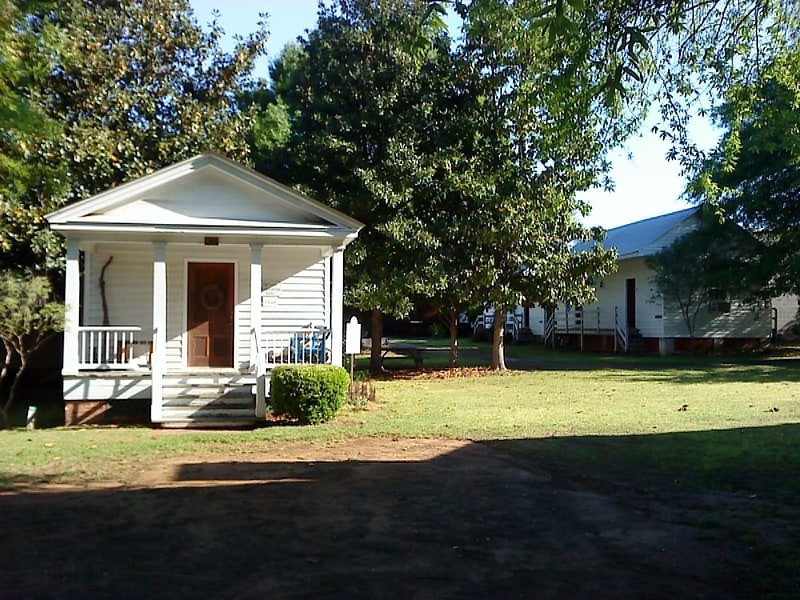
Historical landmark in Montgomery, Alabama. Old Alabama Town is a collection of restored 19th- and 20th-century structures reflecting the lives of the people who settled and developed central Alabama. It stretches along six blocks in the heart of historic downtown Montgomery, Alabama, depicting a cross-section of architecture, history, and lifestyles from an elegant townhouse to rural pioneer living.
Old Alabama Town was developed and is administered by the Landmarks Foundation of Montgomery, a non-profit corporation that came into being in 1967. Since the purchase of the 1850s Ordeman Townhouse and its dependencies in 1968, Landmarks has acquired and restored more than 50 buildings on the site.
The Lucas Tavern serves as the visitor and information center and was formerly located in Waugh along the Federal Road. General Lafayette stayed the night at the tavern on his way to Montgomery.[11]
Address: 301 Columbus St, 36104 Montgomery (Downtown Montgomery)
Dexter Avenue Baptist Church
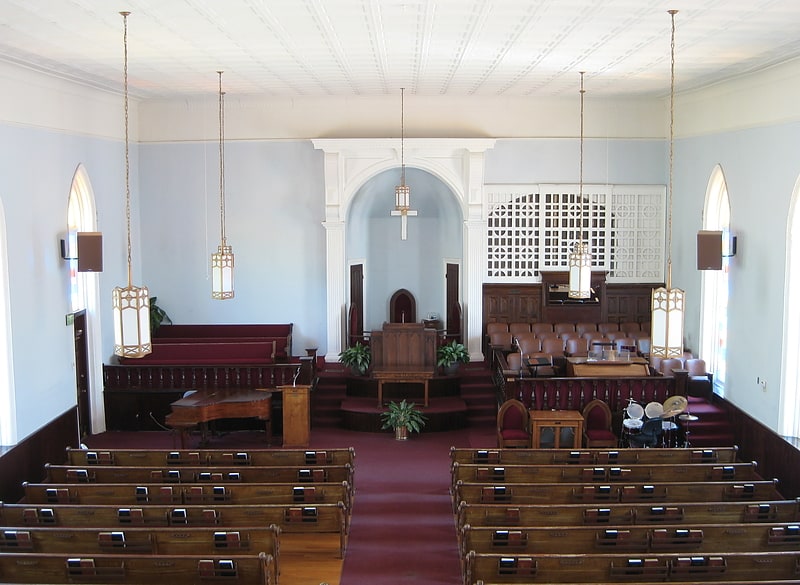
Church in Montgomery, Alabama. Dexter Avenue Baptist Church is a Baptist church in Montgomery, Alabama, United States, affiliated with the Progressive National Baptist Convention. The church was designated as a National Historic Landmark in 1974 because of its importance in the civil rights movement and American history. In 1978 the official name was changed to the Dexter Avenue King Memorial Baptist Church, in memory of Dr. Martin Luther King Jr. who was pastor there and helped organize the Montgomery bus boycott in 1955 during the civil rights era. The church is located steps away from the Alabama State Capitol.
On January 1, 2008, the US Government submitted the church to UNESCO as part of an envisaged future World Heritage Site nomination, because of this important history. It is on the UNESCO "Tentative List of World Heritage Sites".[12]
Address: 454 Dexter Ave, 36104-3743 Montgomery (Downtown Montgomery)
Alabama Governor's Mansion
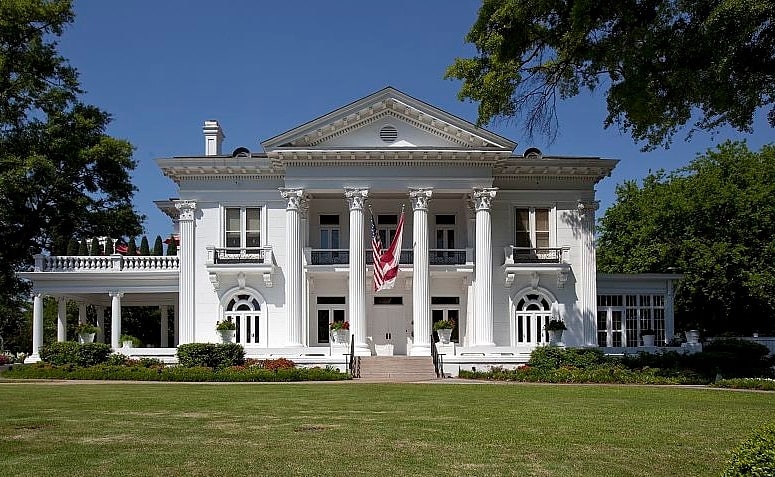
Government office in Montgomery, Alabama. The Alabama Governor's Mansion is the official residence of the governor of Alabama and the governor's family in Montgomery, the capital city of Alabama. The current Governor of Alabama, Kay Ivey lives at the governor's mansion. The original governor's mansion for Alabama was occupied from 1911 until 1950, when the current mansion was acquired. The current mansion was added to the National Register of Historic Places on July 3, 1972.[13]
Address: 1142 S Perry St, 36104-5065 Montgomery
Court Square Fountain
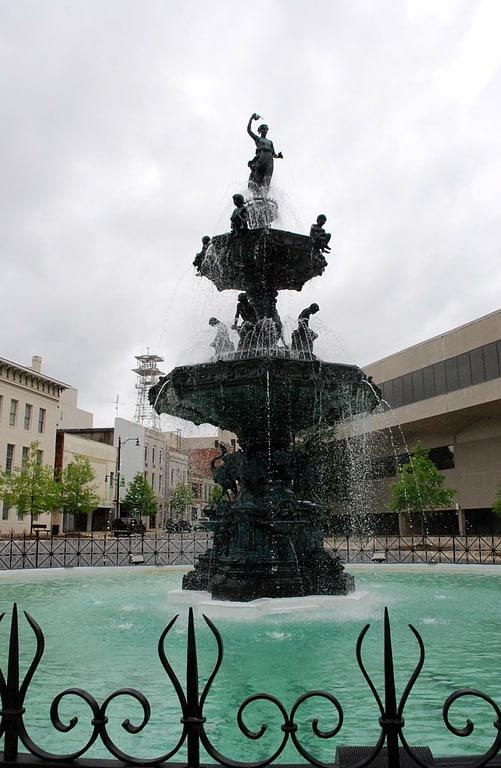
The Court Square Fountain, in the Court Square-Dexter Avenue Historic District of Montgomery, Alabama, was established in 1885 on top of an artesian well, which native Alabamians used long before the area was settled. The fountain contains statues based on Greek mythology. The surrounding area, once the location for Montgomery's bustling slave trade, has seen most of its historical buildings torn down; the fountain's statues were replaced with aluminum ones in the 1980s.[14]
Address: 2 Dexter Ave, 36104 Montgomery (Downtown Montgomery)
Temple Beth Or
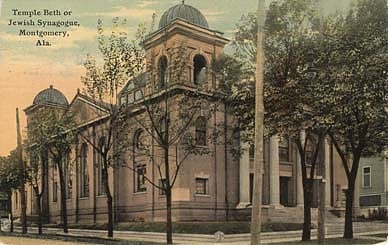
Reform synagogue in Montgomery, Alabama. Temple Beth Or is a historic reform Jewish congregation in Montgomery, Alabama.[15]
Address: 2246 Narrow Lane Road, Montgomery
First Baptist Church
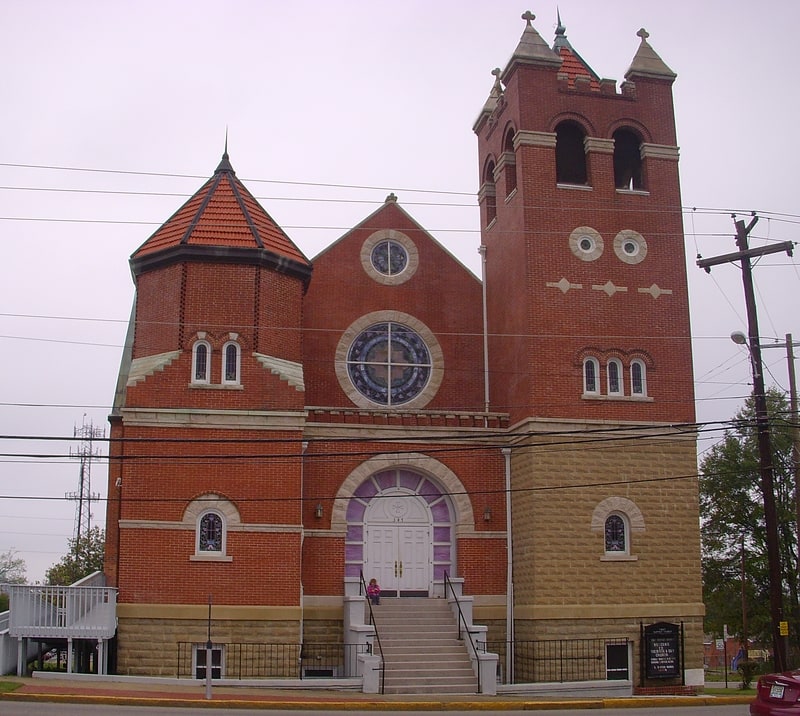
Baptist church in Montgomery, Alabama. The First Baptist Church on North Ripley Street in Montgomery, Alabama, is a historic landmark. Founded in downtown Montgomery in 1867 as one of the first black churches in the area, it provided an alternative to the second-class treatment and discrimination African-Americans faced at the other First Baptist Church in the city.
In the first few decades after its establishment the First Baptist Church became one of the largest black churches in the South, growing from hundreds of parishioners to thousands. Almost a hundred years later, in the 1950s and 1960s, it was an important gathering place for activities related to the Civil Rights Movement, and became associated with the Montgomery bus boycott and the Freedom Rides of May 1961. The church was listed by the Alabama Historical Commission on the Alabama Register of Landmarks and Heritage on May 5, 2000.[16]
Address: 347 N Ripley St, 36104-2730 Montgomery (Downtown Montgomery)
Mount Zion AME Zion Church
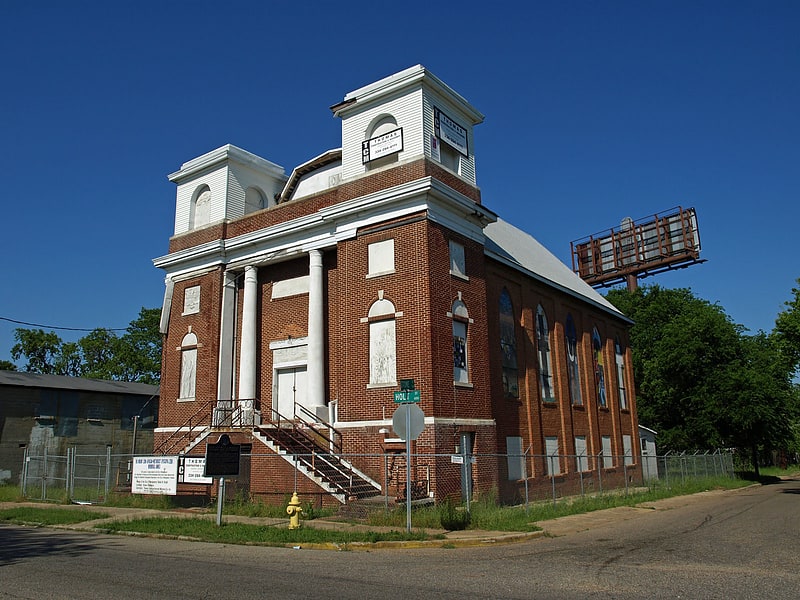
Methodist church in Montgomery, Alabama. The Mount Zion African Methodist Episcopal Zion Church, also known as the Mount Zion AME Zion Church Memorial Annex, is a historic church in Montgomery, Alabama, United States. Located on 467 Holt Street, it was built in 1899 and extensively remodeled in 1921.
In 1955 the Montgomery Improvement Association, who organized the Montgomery bus boycott, was formed in the building. During the Selma to Montgomery marches in 1965, marchers rested at the church on their way to the Capitol. It is included on the Selma to Montgomery National Historic Trail. The congregation moved to a new location in 1990, and on November 4, 2002, the building was added to the U.S. National Register of Historic Places.
The sides of the building are decorated with murals depicting Martin Luther King Jr. Rosa Parks, and the Selma to Montgomery marches.[17]
Greyhound Bus Station
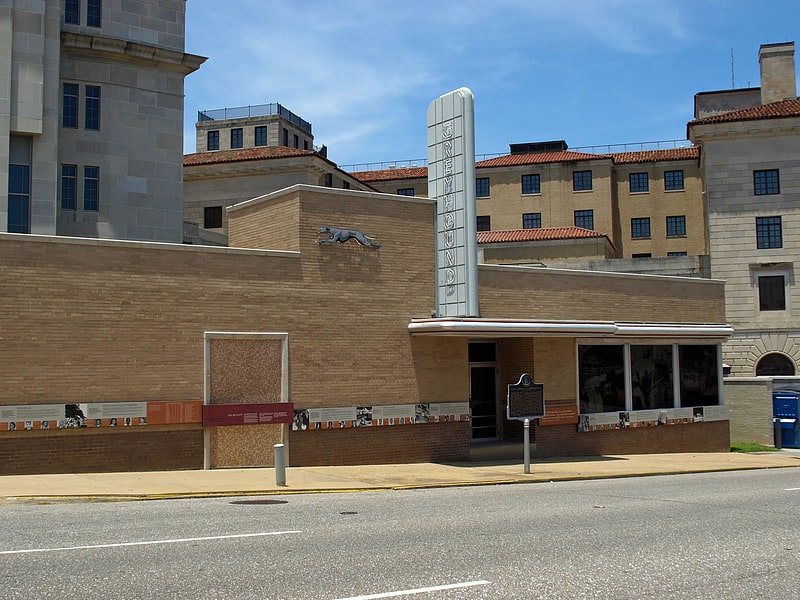
Museum in Montgomery, Alabama. The Freedom Rides Museum is located at 210 South Court Street in Montgomery, Alabama, in the building which was until 1995 the Montgomery Greyhound Bus Station. It was the site of a violent attack on participants in the 1961 Freedom Ride during the Civil Rights Movement. The May 1961 assaults, carried out by a mob of white protesters who confronted the civil rights activists, "shocked the nation and led the Kennedy Administration to side with civil rights protesters for the first time."
The property is no longer used as a bus station, but the building was saved from demolition and its façade has been restored. The site was leased by the Alabama Historical Commission and a historical marker was located in front of the building. In 2011, a museum was opened inside the building, and it was listed on the National Register of Historic Places. The museum won a national preservation award from the National Trust for Historic Preservation in 2012.[18]
Address: 205 S Lamar St, Montgomery (Downtown Montgomery)
Agudath Israel Etz Ahayem
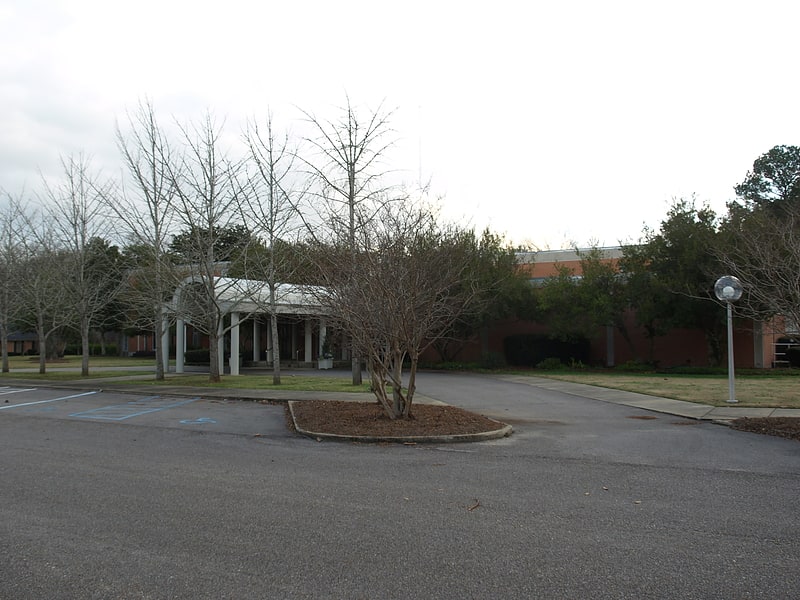
Conservative synagogue in Montgomery, Alabama. Agudath Israel Etz Ahayem is a Conservative Jewish congregation located at 3525 Cloverdale Road in Montgomery, Alabama.
Agudath Israel was established as an Orthodox synagogue in 1902 by Yiddish speaking Ashkenazi Jews, recent Eastern European immigrants who rejected the Reform practices of Montgomery's established Congregation Kahl Montgomery/Temple Beth Or. After renting quarters for a number of years, the congregation purchased its first permanent building on Monroe Street in 1914, and constructed a new building at McDonough and High Street in 1928.
Agudath Israel came to national attention in 1955 because of the Civil rights movement activism of then-rabbi Seymour Atlas, who eventually left the synagogue as a result of it. In 1957 it constructed its current building on Cloverdale Road, and joined the United Synagogue of Conservative Judaism, though it subsequently hired several Orthodox rabbis. Cynthia Culpeper became Agudath Israel's rabbi in 1995, the first Conservative woman rabbi in Alabama, but left in 1997 to seek treatment for AIDS, the result of an accidental needle prick while working as a nurse.
Etz Ahayem, was established in 1912 by Ladino speaking Sephardi Jews, particularly from Rhodes. The congregation grew slowly, and completed construction of its first building in 1927. In 1962 the congregation moved to a new building, but by the 1990s it had dwindled, as children of congregants moved away from Montgomery, and the synagogue had difficulty finding rabbis to lead it.
The congregations merged in 2001, and adopted the current name. In 2007 Scott Kramer became Agudath Israel Etz Ahayem's third rabbi since the merger. As of 2015, Kramer was the rabbi and Joy Blondheim was the president.[19]
Trinity Presbyterian Church
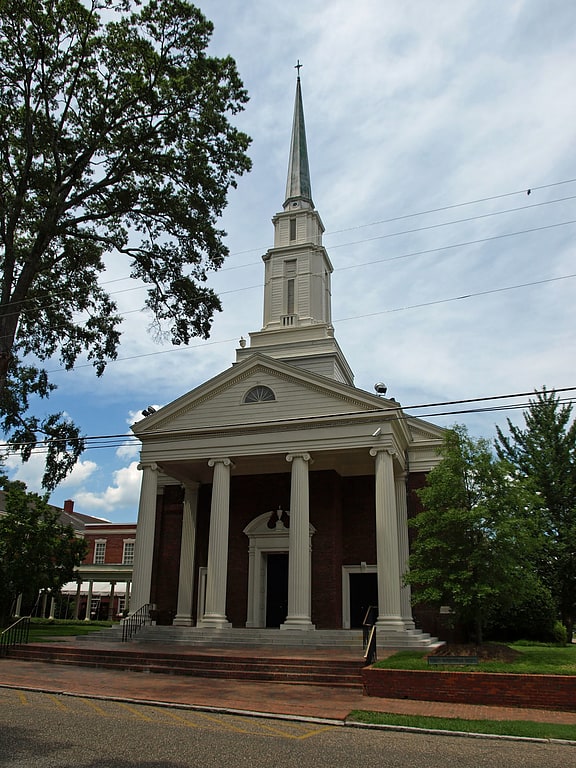
Church in Montgomery, Alabama. Trinity Presbyterian Church in Montgomery, Alabama is a flagship and founding congregation within the Presbyterian Church in America, PCA. Trinity has about 1,300 members.[20]
Address: 1728 S Hull St, Montgomery
St. John's Episcopal Church
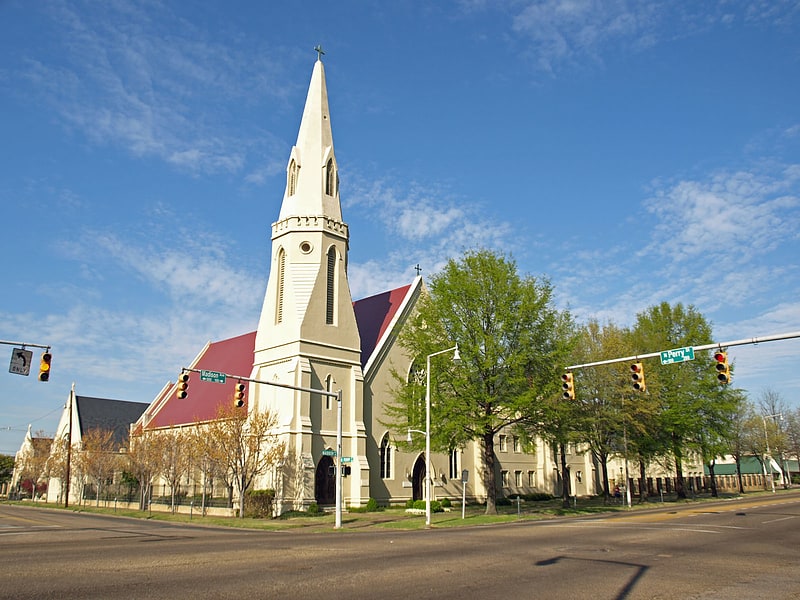
Church in Montgomery, Alabama. St. John's Episcopal Church is a historic Gothic Revival church in Montgomery, Alabama, United States. It was designed by the New York City architectural firm of Frank Wills and Henry Dudley. The church was placed on the National Register of Historic Places on 24 February 1975.[21]
Address: 113 Madison Ave, 36104 Montgomery (Downtown Montgomery)
Huntingdon College

Liberal arts college in Montgomery, Alabama. Huntingdon College is a private Methodist liberal arts college in Montgomery, Alabama. It was founded in 1854 as a women's college.[22]
Address: 1500 E Fairview Ave, 36106-2148 Montgomery
Wright Brothers Park
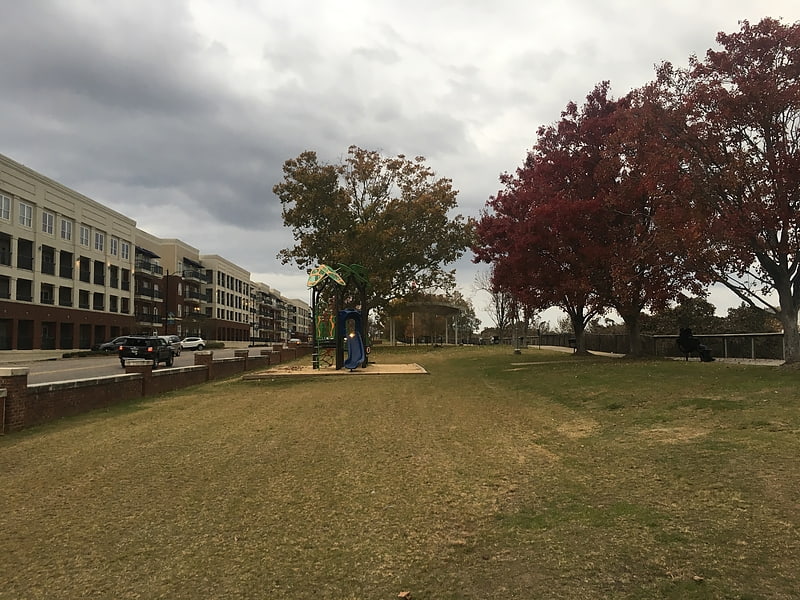
Park in Montgomery, Alabama. Wright Brothers Park is an urban park in Montgomery, Alabama, United States.
The park was renamed from Overlook Park to Wright Brothers Park on July 2, 2013, in dedication to the Wright Brothers. The park underwent renovations and redecoration for the dedication. One of the objects of redecoration is a full-scale replica of the Wright Flyer which is right above the Alabama River.
Wright Brothers Park features beautiful views of the Alabama River and the surrounding area. Picnic shelters with off-street parking provide a pleasant place for a family picnic. Amenities include benches, trails with views of the river, and a playground. The park has four picnic tables under a gazebo overlooking the Alabama River (Maxwell Boulevard).[23]
Grove Court Apartments
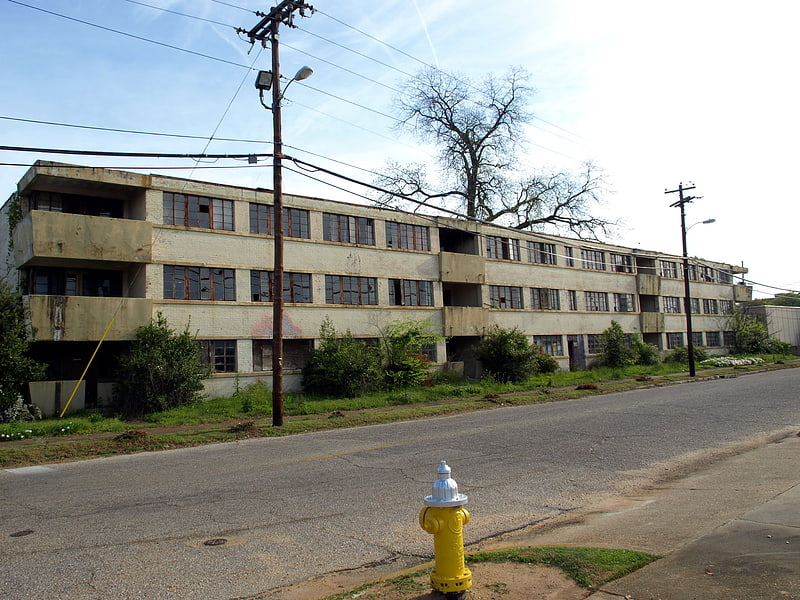
Apartment building in Montgomery, Alabama. The Grove Court Apartments in Montgomery, Alabama is an apartment complex built in 1947. Though it won an award for its design, it was abandoned in the 1990s and has been derelict since. Since 2013, it is listed as a historical site in the National Register of Historic Places listings in Montgomery County, Alabama.[24]
W. A. Gayle Planetarium
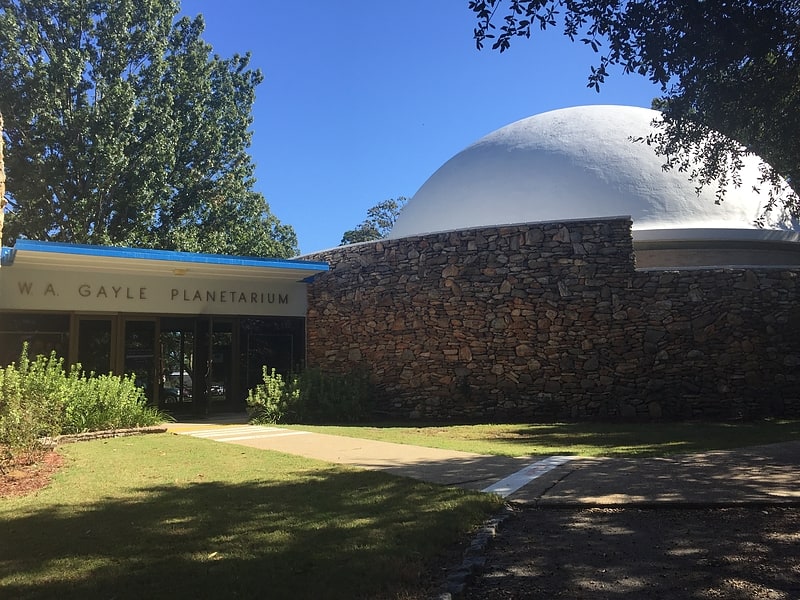
Planetarium in Montgomery, Alabama. The W.A. Gayle Planetarium is operated by Troy University for the city of Montgomery, Alabama. It provides public presentations and exhibits on astronomy, planetary science, and space exploration.[25]
Address: Montgomery, 1010 Forest Ave, Montgomery, Alabama
Faulkner University
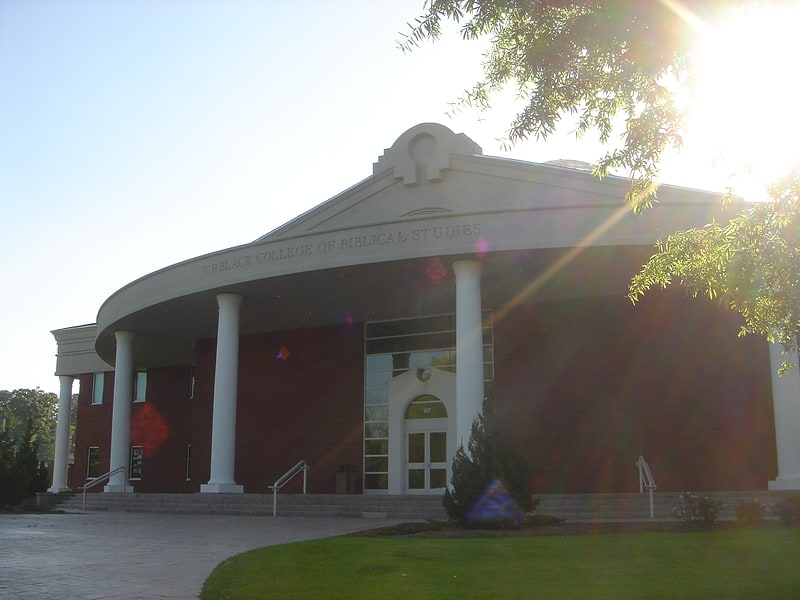
University in Montgomery, Alabama. Faulkner University is a private Christian university in Montgomery, Alabama. It is affiliated with the Churches of Christ. The university was founded in 1942 by Dr. Rex Turner, Dr. Leonard Johnson and Joe Greer as Montgomery Bible School. In 1953 the school's name was changed to Alabama Christian College. In 1965, the college was moved to its present location on Atlanta Highway. The year 1975 marked the beginning of the school's satellite campuses in Mobile, Huntsville and Birmingham. In 1985, the school was renamed Faulkner University in honor of James H. Faulkner, a longtime supporter and chairman of the board.[26]
Address: 5345 Atlanta Hwy, 36109-3323 Montgomery
Holt Street Church of Christ

Church of christ in Montgomery, Alabama. The Holt Street Baptist Church is an abandoned Baptist church in Montgomery, Alabama, United States.
The church served as a meeting place for Montgomery's black community during the Montgomery bus boycott.
Built in 1913, the church closed in 1998, when the congregation moved to a new location in Montgomery.[27]
Address: 945 S Holt St, Montgomery
Dexter Parsonage Museum
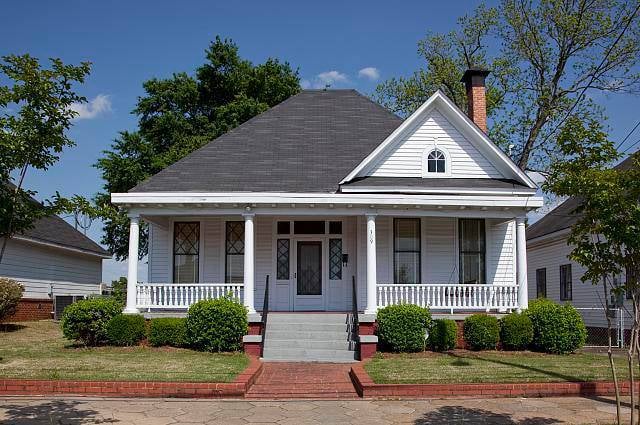
Museum, Historical place, History museum
Address: 315 S Jackson St, 36104-4407 Montgomery
Old Ship African Methodist Episcopal Zion Church

Church in Montgomery, Alabama. Old Ship African Methodist Episcopal Zion Church is a historic African Methodist Episcopal Zion Church in Montgomery, Alabama. It is the oldest African American church congregation in the city, established in 1852. The current Classical Revival-style building was designed by Jim Alexander and was completed in 1918. It is the fourth building the congregation has erected at this location. Scenes from the 1982 television movie, Sister, Sister, were shot at the church. It was placed on the Alabama Register of Landmarks and Heritage on March 3, 1976, and the National Register of Historic Places on January 24, 1991.[28]
Address: 483 Holcombe St, 36104-4113 Montgomery
Greenwood Cemetery
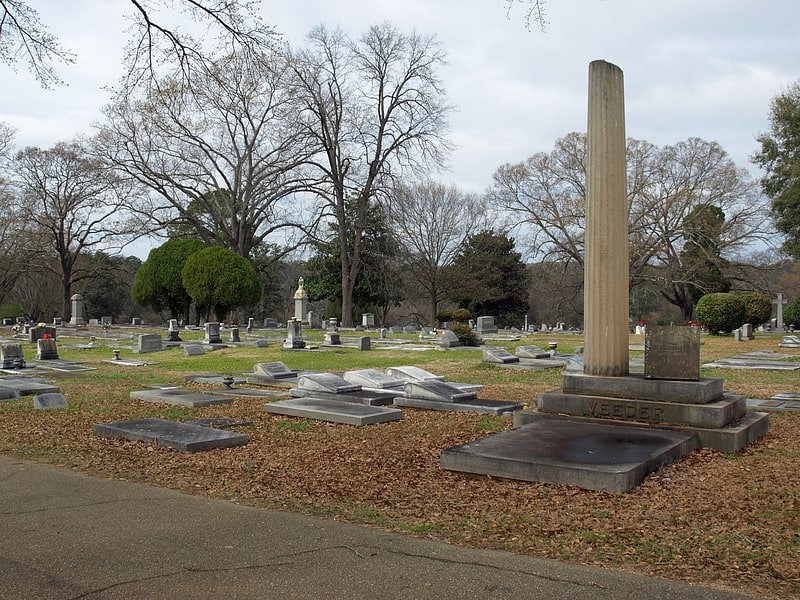
Cemetery in Montgomery, Alabama. Greenwood Cemetery is a cemetery in Montgomery, Alabama, United States.
Notable interments include:
- John Abercrombie, U. S. Congressman
- Bibb Graves, 38th Governor of Alabama
- Dixie Bibb Graves, U. S. Senator and First Lady of Alabama
- J. Lister Hill, U. S. Congressman and Senator
- Reuben Kolb, Alabama's commissioner of agriculture
- William R. Lawley, Jr. United States Army Air Forces officer and Medal of Honor recipient
- Gordon Persons, 43rd Governor of Alabama
- John C. C. Sanders, Civil War Confederate Brigadier General
- George Wallace, 45th Governor of Alabama
- Lurleen Burns Wallace, 46th Governor of Alabama, First Lady of Alabama
Frank M. Johnson Jr. Federal Building and United States Courthouse
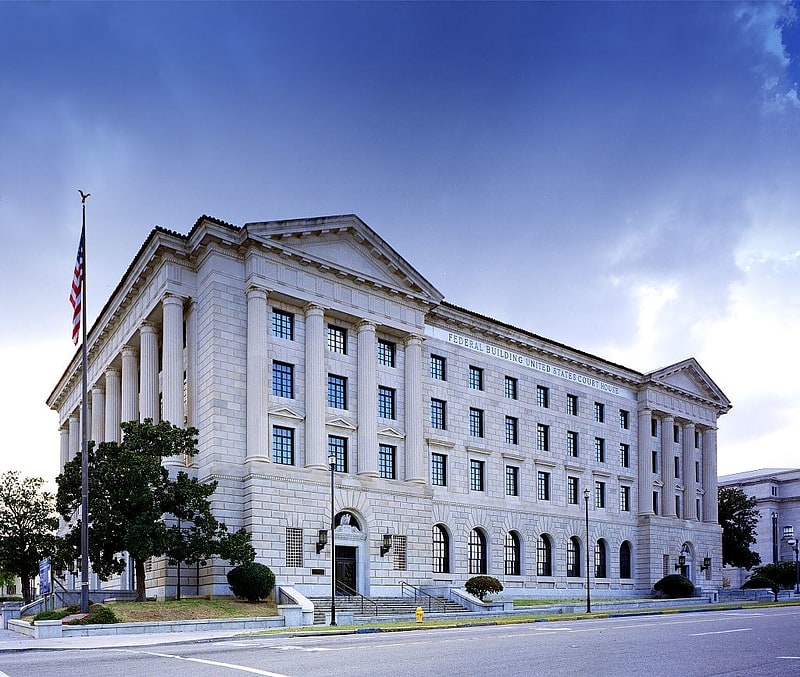
The Frank M. Johnson Jr. Federal Building and United States Courthouse is a United States federal building in Montgomery, Alabama, completed in 1933 and primarily used as a courthouse of the United States District Court for the Middle District of Alabama. The building is also known as United States Post Office and Courthouse—Montgomery and listed under that name on the National Register of Historic Places. In 1992, it was renamed by the United States Congress in honor of Frank Minis Johnson, who had served as both a district court judge and a court of appeals judge. It was designated a National Historic Landmark in 2015.[30]
RSA Tower
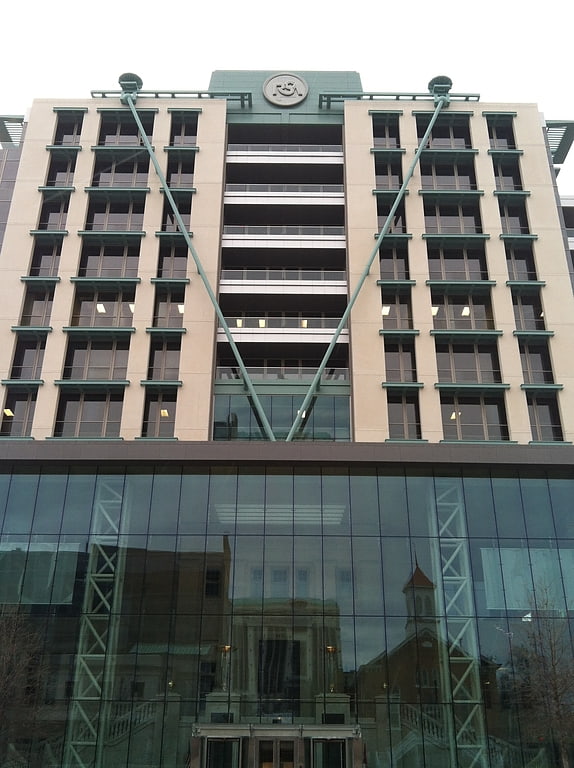
The RSA Judicial Building, also known as RSA Dexter Avenue Building, is office high-rise in Montgomery, Alabama owned by Retirement Systems of Alabama completed in 2011. Built on the grounds of the former home of the Alabama Supreme Court its incorporates the 1926 three-story courthouse complex called the Judicial Building within its 50 ft glass atrium..[31]
SAC's Gallery

Museum, Art gallery, Specialty museum, Art museum, Shopping
Address: 529 S Perry St, 36104-4629 Montgomery (Downtown Montgomery)
Garden District
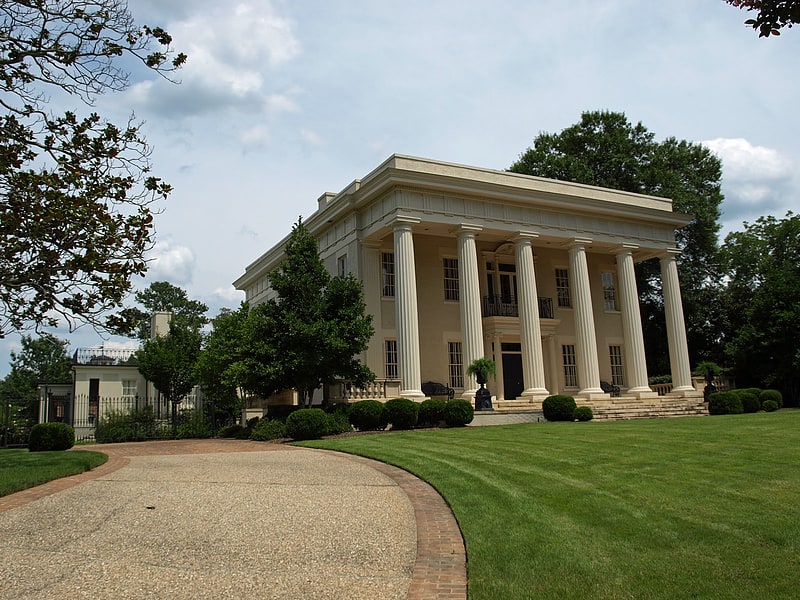
The Garden District is a 315-acre historic district in Montgomery, Alabama.
Garden District is roughly bounded by Norman Bridge Road, Court Street, Jeff Davis Avenue, and Fairview Avenue. It contains 678 contributing buildings with architecture including the Queen Anne, Classical Revival and American Craftsman styles. When listed, the district included 678 contributing buildings and 81 non-contributing buildings. The district was placed on the National Register of Historic Places on September 13, 1984.[32]
Alabama Judicial Building
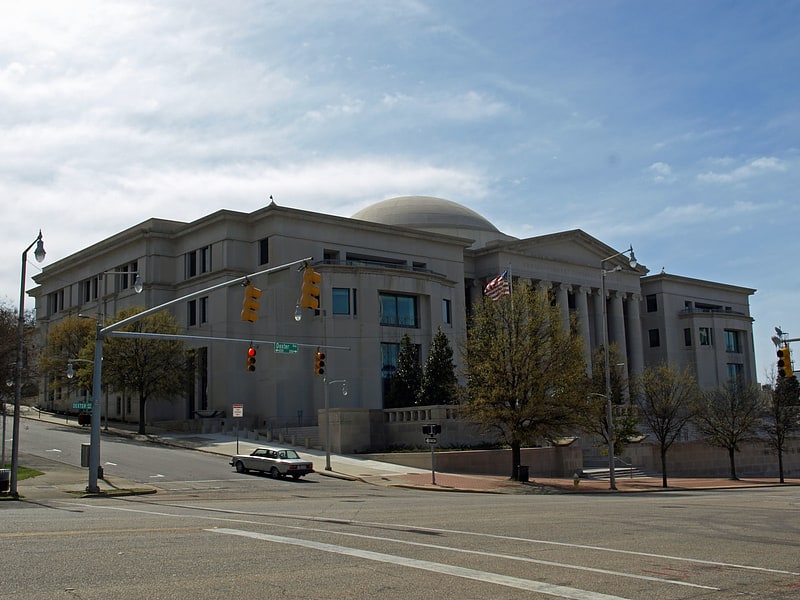
Building in Montgomery, Alabama. Heflin-Torbert Judicial Building, commonly called the Alabama Judicial Building, is a state government building in Montgomery, Alabama. It houses several state judicial agencies, most notably the Supreme Court of Alabama, Alabama Court of Civil Appeals, and Alabama Court of Criminal Appeals. It is the first state court building in the United States to house all three courts under one roof. Additionally, it houses the State Law Library.
The neoclassical-style structure was completed in 1994 at a cost of approximately $35 million.
In 2001, Roy Moore, who was Chief Justice at the time, placed a Ten Commandments monument on public display in the rotunda of the building. This placement of a religious monument in a government judicial building caused a nationwide controversy.[33]